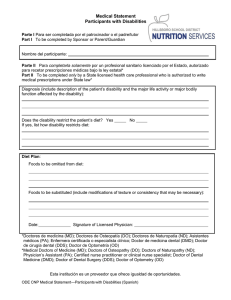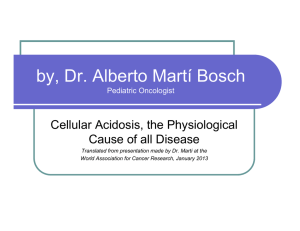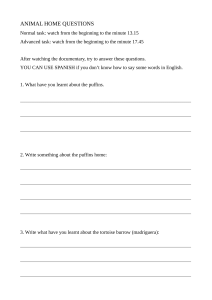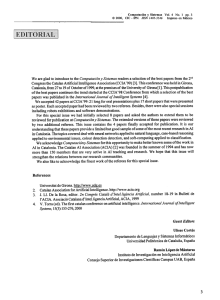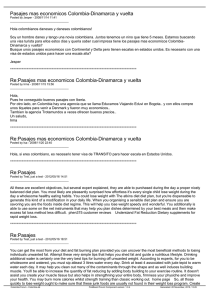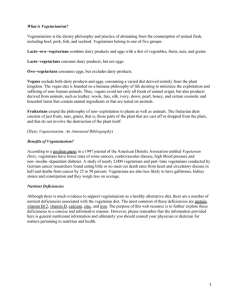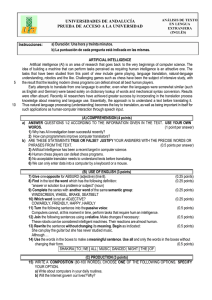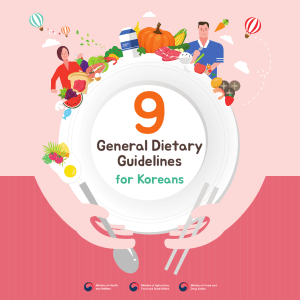The Effect of Size and Diet on Gonad Production by the Chilean Sea Urchin Loxechinus albus
Anuncio
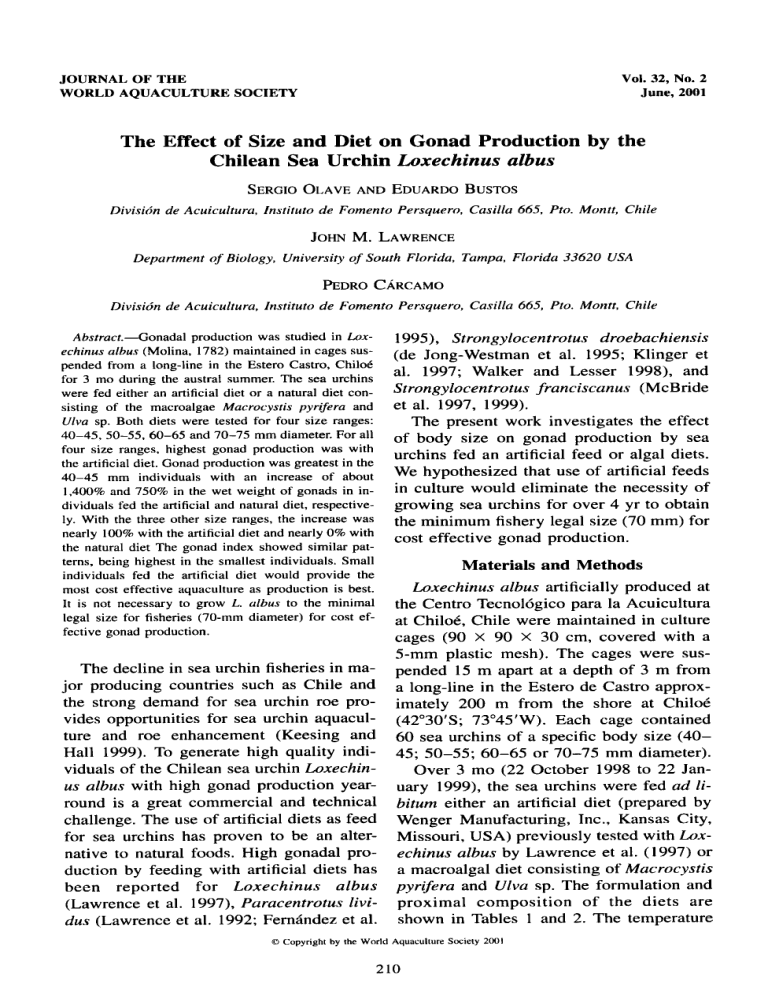
Val. 32, No. 2 June, 2001 JOURNALOFTHE WORLD AQUACULTURE SOCIETY The Effect of Size and Diet on Gonad Production by the Chilean Sea Urchin Loxechinus albus SERGIO OLAVE AND EDUARDO BUSTOS Divisio'n de Acuiculturu, Instituto d e Foment0 Persquero, Cusillu 665. Pto. Montt, Chile JOHNM. LAWRENCE Department of Biology, University of South Florida, Tampa, Floridu 33620 USA PEDRO CARCAMO Divisidn de Acuiculturu, Instituto d e Foment0 Persquero, Casilla 665, Pro. Montt, Chile Abstract.-Conadal production was studied in Loxechinus albus (Molina, 1782) maintained in cages suspended from a long-line in the Estero Castro, ChiloC for 3 mo during the austral summer. The sea urchins were fed either an artificial diet or a natural diet consisting of the macroalgae Macrocystis pyrifera and Ulva sp. Both diets were tested for four size ranges: 40-45, 50-55, 60-65 and 70-75 mm diameter. For all four size ranges, highest gonad production was with the artificial diet. Gonad production was greatest in the 40-45 mm individuals with an increase of about 1,400% and 750% in the wet weight of gonads in individuals fed the artificial and natural diet, respectively. With the three other size ranges, the increase was nearly 100% with the artificial diet and nearly 0% with the natural diet The gonad index showed similar patterns, being highest in the smallest individuals. Small individuals fed the artificial diet would provide the most cost effective aquaculture as production is best. It is not necessary to grow L. ulbus to the minimal legal size for fisheries (70-mm diameter) for cost effective gonad production. 1995), Strongylocentrotus droebachiensis (de Jong-Westman et al. 1995; Klinger et al. 1997; Walker and Lesser 1998), and Strongylocentrotus franciscanus (McBride et al. 1997, 1999). The present work investigates the effect of body size on gonad production by sea urchins fed an artificial feed or algal diets. We hypothesized that use of artificial feeds in culture would eliminate the necessity of growing sea urchins for over 4 yr to obtain the minimum fishery legal size (70 mm) for cost effective gonad production. Materials and Methods Loxechinus albus artificially produced at the Centro Tecnol6gico para la Acuicultura at ChiloC, Chile were maintained in culture cages (90 X 90 X 30 cm, covered with a 5-mm plastic mesh). The cages were susThe decline in sea urchin fisheries in ma- pended 15 m apart at a depth of 3 m from jor producing countries such as Chile and a long-line in the Estero de Castro approxthe strong demand for sea urchin roe pro- imately 200 m from the shore at ChiloC vides opportunities for sea urchin aquacul- (42"30'S; 73'45'W). Each cage contained ture and roe enhancement (Keesing and 60 sea urchins of a specific body size (40Hall 1999). To generate high quality indi- 45; 50-55; 60-65 or 70-75 mm diameter). viduals of the Chilean sea urchin LoxechinOver 3 mo (22 October 1998 to 22 Janus albus with high gonad production year- uary 1999), the sea urchins were fed ad liround is a great commercial and technical bitum either an artificial diet (prepared by challenge. The use of artificial diets as feed Wenger Manufacturing, Inc., Kansas City, for sea urchins has proven to be an alter- Missouri, USA) previously tested with Loxnative to natural foods. High gonadal pro- echinus albus by Lawrence et al. ( 1 997) or duction by feeding with artificial diets has a macroalgal diet consisting of Macrocystis been reported for Loxechinus albus pyrift'ra and Ulva sp. The formulation and (Lawrence et al. 1997), Paracentrotus livi- proximal composition of the diets are dus (Lawrence et al. 1992; Fernhdez et al. shown in Tables 1 and 2. The temperature 0 Copyright by the World Aquaculture Sociely 2001 210 21 1 GONAD PRODUCTION B Y CHILEAN SEA URCHIN TABLEI . Formulation of the prepared feed (% dry weight). Component % dry weight Kelp meal Corn grain Wheat middlings Soybean Fish meal Potassium diphosphate Fish oil Cholesterol Ethoxide Mineralshitamins Vitamin C Carotenoids 14.00 32.00 27.53 11.10 12.00 1.33 0.24 0.30 0.20 0.08 0.08 0.01 TABLE2. Proximate composition (% dry weight) and water content (% wet weight) of the artificial diet, Macrocystis pyrifera, and Ulva sp. Values for the macroalgae are annual means from Westermeier ( I 982). ~ ~~ Artificial Macrocystis diet pyrifera UIva sp. Component Soluble protein Lipid Soluble carbohydrate Fiber Organic matter Water 24 20.1 4.7 62.2 4.6 91.6 27 11.4 6.2 9.74 , A Results The gonad weights at the end of the experiment of individuals of all four size ranges were significantly higher for those fed the artificial diet ( P < 0.01 for 40-45 mm individuals, P < 0.05 for the other size ranges) (Fig. I ) . The gonad weights of in- - - 72.7 87 72.7 82 J dbl +e*oyded t m l g s l dbl 20. ranged from 12 to 15 C in the austral spring and 15 to 18 C in the austral summer (mean = 15 +- 1 C over the experimental period). There were three cages (replicates) for each size range with the artificial feed and two with the macroalgae. The animals were fed ad libitum, with uneaten food removed and fresh food added every 10 d. The artificial feed showed no signs of breaking up or spoilage over this time. The wet body weight and gonad weight was measured at the beginning of the experiment for 15 individuals in each size range to the nearest 0.01 g. Subsequently, the wet body weight and gonad weight were measured for six individuals for each replicate every 2 wk. The gonad index (gonadal wet weight X 100hody wet weight) was calculated (Gonor 1972). Gonad production (both weight and index) between size ranges and between diets were compared statistically with a two way ANOVA and an a posteriori multicomparative analysis by Scheffk’s test (Sokal and Rohlf 1981). 17.1 6.6 12.72 36. 12. T 4. 0. 40. D oJ 22 Od 98 21 Nov 98 21 DecW 20 Jan 99 DATE FIGURE 1. Gonad wet weight ( g ) of Loxechinus albus of different sizes fed an artificial diet or macroalgae over a 3-mo period (Mean SE) A: 40-45 mrn diameter, B: 50-55 mm diameter, C: 60-65 mm diameter, D: 7&75 mm diameter. * 212 OLAVE ET AL. 40 32 4 I diet did not differ significantly with size (P > 0.05). A decrease in the gonad weight and index occurred in the 50-55 mm individuals in January, but not for the other size ranges. Discussion These data confirm that gonad production is greater with an artificial diet than with macroalgae as reported by Lawrence et al. (1991, 1997), Fernandez et al. (1995), de Jong-Westman et al. (1995), Klinger et al. (1997), McBride et al. (1997, 1999), and Walker and Lesser (1998). Undoubtedly much of this difference is the presence of refractory cell walls in the algal diet (McClintock 1986) although the quality of the nutrients could also be a factor. Individuals in the smallest size range used here are at the lower limit for sexual maturity, as Loxechinus albus reaches sexual maturity in the field at a diameter between 35-45 mm (Bustos et al. 1991). The gonads reach maturity and spawning occurs in the austral spring from November to December (Bay-Schmith et al. 1981). Thus the sea urchins were at the beginning of gonadal development when the experiment began. oJ 22 O d 88 21Nov98 21 D-98 20 JM 99 The size of the gonads and the gonad index DATE at that date were directly related to body FIGURE 2. Gonad index of Loxechinus albus of dqsize. Small individuals, 40-45 mm in diferent sizes fed an artijicial diet o r macroalgae over ameter, had much smaller gonads than larga 3-mo period (Mean -C SE.). A: 40-45 mm diameter, B: 50-55 mm diameier, C: 60-65 mm diameier, er individuals. After 3 mo feeding on the D: 70-75 mm diameter. artificial diet or macroalgae to the date when gonad maturity could be expected, the gonads of the small individuals had individuals fed the macroalgae increased dur- creased approximately 1,400% and 750% ing the experiment only in the smallest (40- respectively. The increase in gonad weight 45 mm) individuals. The gonad weight at of the other three size ranges was nearly the end of the experiment of sea urchins fed 100% with the artificial diet and almost nil the artificial diet was significantly related to with the macroalgae. The gonad indices found here at the end body size (P < 0.05). The gonad indices of sea urchins fed the of the experiment are similar to those reartificial diet was significantly larger than ported for Loxechinus albus by Lawrence those of individuals fed the macroalgal diet et al. (1997). Although the gonadal weights (P < 0.01 for 40-45 mm individuals, P < at the end of the experiment with the arti0.05 for the other sizes) (Tables 5 , 6, Fig. ficial diet were directly related to body size, 2). In contrast to the gonad weights, the go- the gonad index was similar at all sizes and nad indices of individuals fed the artificial the efficiency of gonadal production was in- GONAD PRODUCTION BY CHILEAN SEA URCHIN versely related to body size. The decrease in gonad size and index in the last month of the experiment in the 50-55 mm individuals probably indicates spawning. The commercial development of culture of the sea urchin Loxechinus albus has been held back by the long period of culture and the high costs required to obtain individuals of commercial size, i.e., 70 mm (3-5 yr: Zegers et al. 1983; Bustos et al. 1992; Olave et al. 1993). This present work indicates that, in culture, it would not be necessary to grow L. albus in aquaculture to a very large size since 40-45 mm individuals, fed with artificial diet, offer better economic prospects. These small individuals fed an artificial diet have a higher gonad production efficiency and similar gonad indices compared to larger individuals. Small L. albus always have higher indices than individuals of all size ranges fed macroalgae. These results also have implications for “bulking” (gonad conditioning, wild stock enhancement) of sea urchins obtained from areas where food is limited and gonads are not produced (Moylan 1997; Robinson and Colborne 1997; Hagen 1998). Current fisheries regulations prohibit taking individuals < 70 mm as the gonads are too small for marketing. It is possible that individuals 40-45 mm individuals could be fished for bulking. Acknowledgments The present work was funded by Project FONDEF D/96/1101 “Diversificaci6n de la Acuacultura en la X Regidn, Chile”. (Diversification of Aquaculture in the X Region, Chile). We thank Dr. A. L. Lawrence for formulating the diet and Wenger Manufacturing, Inc., Kansas City, Missouri, USA for supplying the extruded feed. We are grateful for the collaboration of Miss Claudia Puebla and Mr. RenC Silva in the field work. Literature Cited Bay-Schmith, E., C. Werlinger, and J. Silva. 1981. Ciclo anual de reproduccibn del recurso Loxechin- 213 us albus entre la X y XI1 Regibn. Informe final Proyecto de Investigacibn Subsecretaria de Pesca. Universidad de Concepcibn. Concepcibn, Chile. Bustos, E., C. Godoy and R. Troncoso. 1991. Investigacibn repoblamiento de recursos bentbnicos Area Piloto IV Regibn. Etapa 111. 4. Investigaciones en erizo Loxechinus albus (Molina. 1782). CORFO-IFOP (SGI-IFOP 91/5). Bustos, E., S. Olave, R. Troncoso, and C. Godoy. 1992. Investigacibn repoblamiento de recursos bentdnicos Area Piloto IV Regibn. Etapa IV. 5. Investigaciones en erizo Loxechinus albus (Molina, 1782). CORFO-IFOP (SGI-IFOP 92/8). de Jong-Westman, M., B. E. March, and T. H. Carefoot. 1995. The effect of different nutrient formulations in artificial diets on gonad growth in the sea urchin Srrongylocentrotus droebachiensis. Canadian Journal of Zoology 73: 1495-1502. Fernhdez, C., E. Dombrowski, and A. Caltagirone. 1995. Gonadal growth of adult sea urchin Paracentrotus lividus (Echinodermata: Echinoidea) in rearing: the effect of different diet type. Pages 269-275 in R. Emson, A. B. Smith, and A. Campbell, editors. Echinoderm research 1995. A.A. Balkema, Rotterdam, The Netherlands. Gonor, J. J. 1972. Gonad growth in the sea urchin Strongylocentrotus purpurarus (Stimpson) (Echinodermata: Echinoidea) and the assumptions of gonad index methods. Journal of Experimental Marine Biology and Ecology 19:89-103. Hagen, N. T. 1998. Effect of food availability and body size on out-of-season gonad yield in the green sea urchin, Srrongylocenrrotus droebachiensis. Journal of Shellfish Research 17: 1,533-1.539. Keesing, J. K. and K. C. Hall. 1999. Review of harvests and status of world sea urchin fisheries points to opportunities for aquaculture. Journal of Shellfish Research 17597-1,604. Klinger, T. S., J. M. Lawrence, and A. L. Lawrence. 1997. Gonad and somatic production of Srrongylocenrrotus droebachiensis fed manufactured feeds. Bulletin of the Aquaculture Association of Canada 1997:35-37. Lawrence, J. M.; L. Fenaux, M. C. Corre, and A. Lawrence. 1992. The effect of quantity and quality of prepared diets on production in Paracenrrotus lividus (Echinodermata: Echinoidea). Pages107-110 in L. Scaiera-Liaci and C. Canicatti, editors. Echinoderm research 1991. A.A. Balkema, Rotterdam, Netherlands. Lawrence, J. M., S. Olave, R. Otaiza, A. Lawrence, and E. Bustos. 1997. Enhancement of gonad production in the sea urchin Loxechinus albus in Chile fed extruded feeds. Journal of the World Aquaculture Society 28:9 1-96. McBride, S. C., W. D. Pinnix, J. M. Lawrence, A. Lawrence, and T. M. Mulligan. 1997. The effect of temperature on production of gonads by the sea 214 OLAVE ET AL. urchin Strongylocentrotus franciscanus fed natural and prepared diets. Journal of the World Aquaculture Society 28:357-365. McBride, S. C., J. M. Lawrence, A. L. Lawrence, and T. J. Mulligan. 1999. Ingestion, absorption, and gonad production of adult Strongylocentrotus franciscanus fed different rations of a prepared diet. Journal of the World Aquaculture Society 30: 364-370. McClintock, J. B. 1986. On estimating energetic values of prey: implications in optimal diet models. Oecologia 70:161-162. Moylan, E. 1997. Gonad conditioning and wild stock enhancement of the purple sea urchin Paracentrotus lividus on the west coast of Ireland. Bulletin of the Aquaculture Association of Canada 97-1: 38-41. Olave, S., C. Godoy, and R. Troncoso. 1993. Investigaci6n repoblamiento de recursos bent6nicos Area Piloto 1V Regi6n. Etapa V. 4. Erizo ( b x e chinus albus). CORFO-IFOP (SGI-IFOP 93/8). Robinson, S. M. C. and L. Colborne. 1997. Enhanc- ing roe of the green sea urchin using an artificial food source. Bulletin of the Aquacultural Association of Canada. 97-1:14-20. Sokal, R. R. and F. J. Rohlf. 1981. Biometry. The principles and practice of statistics in biological research, second edition. W. H. Freeman and Co. New York, USA. Walker, C. M. and M. P. Lesser. 1998. Manipulation of food and photoperiod promotes out-of-season gametogenesis in the green sea urchin, Strongylocentrotus droebachiensis: implications for aquaculture. Marine Biology 132:663-676. Westermeier, R. 1982. Zonierung, hiomasse, energiegehalt und schwermetallakkumulation mariner algen aus Chile, Helgoland und Spanien. Inaugural Dissertation Justus-Liebig Universitat, Gieben. Zegers, J., M. Oliva, C. Hidalgo, and L. Rodriguez. 1983. Crecimiento de Lonechinus albus (Molina, 1782) (Echinodermata: Echinoidea) en sistemas de jaulas suspendidas a media agua. Memoires de la Asociaci6n Latinoamericano de Acuicultura 5: 369-378.

